

Staged Magnetic Compression of FRC Targets to Fusion Conditions John Slough, PI Helion Energy: David Kirtley, CEO
Project Lead 20 Tesla ARPA-E Experiment 40 Tesla Reactor Existing Facilities and Expertise Theory and Code Development 12 Tesla Experiment Upgrade Implement MHD and Particle Codes
The Fusion Engine 1. Formation – Two FRC plasmoids are dynamically formed by sequential field reversal 2. Acceleration – FRC plasmoids are accelerated to high velocities (>300 km/s) 3. Merging – Two supersonic plasmoids collide and merge converting kinetic into ion thermal energy 4. Compression – FRC is adiabatically compressed to fusion temperatures Artist’s animation of the FE 5. Energy Generation – Spent plasma, fusion ions, and neutrons are converted to energy 2D Magnetohydrodynamic simulation of the FE
Energy Density Low Optimal High Material limit pulsed operation 10 Total Cost of Plant ($B) 50 Tesla Limit Low Energy Devices: Total Cost Steady/Magnetic High Energy Devices Purely Inertial 1 Wall heating limit for continuous operation 0.1 Reactor costs Fusion Driver (heating) costs Fission 0.1 10 1000 10 5 0.01 Power Density (MW/m 3 )
Key Approach Developed to be economically competitive • 50 MW - rapid development, modular power markets • Direct fusion particle energy to electricity- output efficiency • Magnetic/Inductive compression – input efficiency, massless, and <$0.03/MJ
Technology Demonstrators IPA-C Grande IPA LSX, PhD – Full Scale & Stability Millisecond lifetime IPA – Merging Merged FRC confinement IPA-C – Heating and compression 1 keV D ions Grande – High field operation 5+ keV D ions ARPA-E VENTI 12 T esla Compression FEP 20 T esla Compression FEP-G 40 T esla Reactor
Too Big Too Hard Fundamentally large scale Fundamentally inefficient Just Right Scalable, Low Cost, and Efficient
Recommend
More recommend